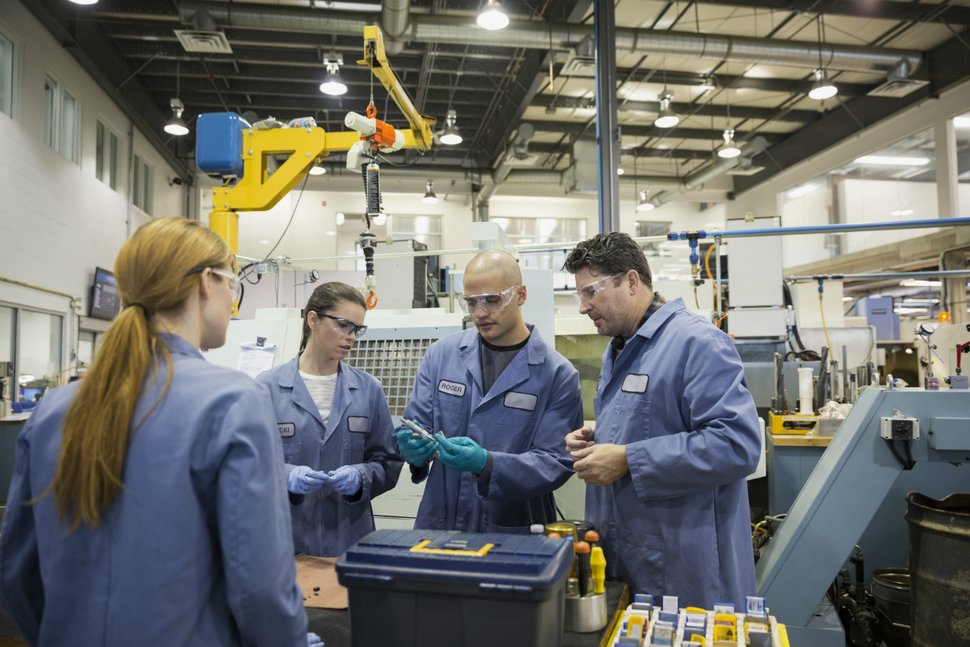Originally published on U.S. News.
 EFFORTS ABOUND AT THE federal, state and local levels to renew interest in vocational education and apprenticeship programs as a way to help fill the skills gap.
EFFORTS ABOUND AT THE federal, state and local levels to renew interest in vocational education and apprenticeship programs as a way to help fill the skills gap.
However, new research out of Cornell University shows that such programs, while connecting employers with the skilled employees they need, are largely leaving women out of the picture.
Vocational high school training in working class communities reduced both men’s and women’s odds of enrolling in a four-year college, researchers found. And to be sure, the aim of such career and technical programs is to get students the skills they need to enter the workforce to fill in-demand jobs as quickly as possible — many students who take such courses either go straight into the workforce or enroll in an apprenticeship or some type of professional certificate program.
But career and technical high school courses, they discovered, led to different outcomes for men and women when they looked for jobs.
Men not only enrolled vocational high school programs in greater numbers, but they also had higher rates of employment and earned comparable wages relative to men who attended high school in non-blue-collar communities.
In contrast, women who attended high school in working class communities were less likely to be employed at all and less likely to work in professional occupations when they were employed. They also earned far less than their female counterparts from non-blue-collar communities.
“This curricular tradeoff did not penalize men in the labor market, at least in early adulthood, but it restricted women’s opportunities to get good jobs,” said April Sutton, a postdoctoral fellow at Cornell University’s Population Center and lead author of the study.
Moreover, even the women who did obtain high-skilled jobs often found themselves still unable to nab the good paying positions. Among high school graduates ages 25-28 in such jobs, the hourly gender wage gap was 22 percent, with women making 78 cents for every dollar men make.
“The disparity is striking for a millennial cohort of women for whom the pay gap has substantially narrowed on average,” Sutton said.
The researchers used data from a longitudinal education study from 2002 designed by the National Center for Education Statistics that included a nationally representative study of high school sophomores. The cohort was tracked through early adulthood with follow-up surveys conducted in 2004, 2006 and 2012.
The research couldn’t be timelier.
A bipartisan group of House members introduced a bill Tuesday to update the long overdue career and technical education law, which provides federal support to state and local career and technical education programs so students can gain experience in high-skill, in-demand fields.
The law has not been updated in more than a decade – a time during which the U.S. economy has undergone a sea change – and there is broad push from both sides of aisle and in both chambers to not only bring it into current times, but also to make it more flexible for states to shift how they use funds to respond to changing economic needs.
Indeed, one of the most pressing issues facing many career and technical programs is their lack of capacity.
Philadelphia’s public school system, for example, reported that it received 11,000 applications for its career and technical education programs in 2014, but only had room and resources for 2,500. And the waitlist for such programs in Massachusetts is 4,600 students deep.
“The importance of career and technical education has grown exponentially across the country,” said Rep. Glenn “GT” Thompson, R-Pa., and co-author of the legislation. “This well-engineered and robust reauthorization aims to close our nation’s skills gap by creating clear pathways to education and training for students eager to pursue careers in vital technical fields.”
The bill includes provisions to ensure all students, including historically disadvantaged and vulnerable students, have access to such programs. But the language stops short of specifically singling out access for female students.
The White House has been particularly focused on this issue as well. For the past three years, President Barack Obama has used his State of the Union address to tout the potential benefits of apprenticeship programs, especially when it comes to filling the roughly 5 million job openings in the U.S. and putting a dent in the skills gap. He’s also called for a doubling in the number of apprenticeships over the next five years, and made repeated attempts to increase federal funding for apprenticeship programs in his budget proposals.
Those efforts, however, have largely fallen on deaf ears, in part because of the hard-to-shed stereotype that technical education amounts to shop class for students who aren’t very bright.
And while there has been lots of energy and political capital spent on increasing access to science, technology, engineering and math, or STEM, for girls at both at the federal, state and local levels, the question of what options they’re left with upon completing career and technical education programs has largely been overlooked.
It raises questions, Cornell’s Sutton said, “about how high school training for these male-dominated, local jobs would negatively impact gender inequality, and it emphasizes the importance of considering gender in debates about the best type of high school training to succeed in today’s economy.”
Lauren Camera, Education Reporter





